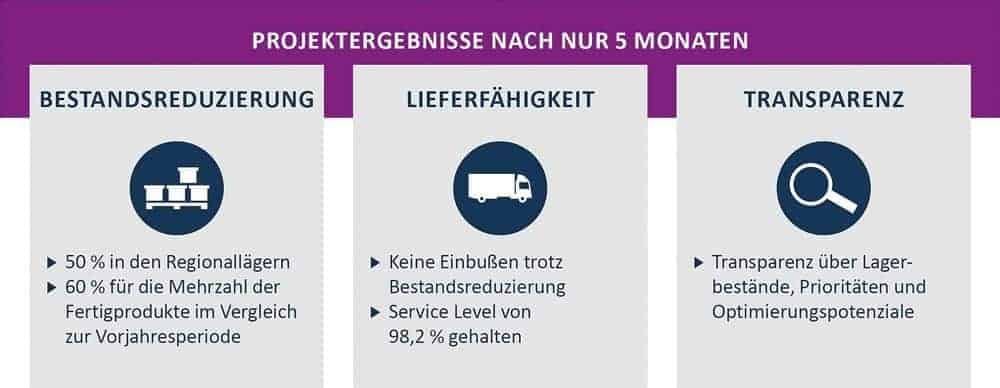JIT, agile & demand-driven - use cases


Use case: pharmaceutical industry
For a leading pharmaceutical company, Camelot developed a four-step approach that was used to establish an integrated supply chain operating model within the framework of demand-driven SCM.
To overcome the challenge of fragmented supply chain processes and limited responsibilities, and to provide transparency and visibility into the pharmaceutical manufacturer's supply chain, the first step was to set global business priorities.
It was essential to establish a global end-to-end supply chain planning process involving all relevant parties. Within the process, it was important that globally defined goals, such as above all alignment with actual customer demand, steer the entire supply chain.
The next step was to establish end-to-end visibility and transparency within the supply chain. An important building block here was the introduction of a central and consistent planning platform. With SAP SCM, the globally defined planning process could be mapped in the IT infrastructure.
As SAP SCM is an established standard software for standard planning, further intelligent planning methods were introduced to achieve complete demand-driven supply chain planning, here mainly the SAP-based Camelot Demand-driven Lean Planning Suite (CLS).
With the CLS DDMRP module, the pharmaceutical manufacturer optimized its inventories worldwide. This alone led to a reduction potential in the amount of $240 million.
A feasible, reliable and optimized production schedule was achieved using CLS's production module, Demand-driven Rhythm Wheel Planning (DDRWP), which smooths out fluctuations in production.
Within just one of the production plants, this generated additional sales potential of $100 million. In tablet production, variability was reduced by 60 percent.
For the future, the company is evaluating the implementation of DDMRP and DDRWP based on S/4 Hana and SAP Integrated Business Planning.
A key aspect of the project's success was embedding the demand-driven mindset in the business through new roles that have both the capacity and authority to implement the shift from reactive to proactive supply chain planning.
Benefits achieved
- Integrated Demand-driven Supply Chain
- $240 million potential from inventory reduction
- 60 percent less variability in tablet production
- Additional sales potential of $100 million
Use case: Consumer goods industry
A 30 to 60 percent reduction in finished goods inventory: a remarkable result for a leading consumer goods company that has had supply chain optimization at the top of its agenda for 15 years and has already cut its inventory reach nearly in half over the same period.
In recent years, however, further improvements have only been possible to a limited extent. The reason: an increasingly complex supply chain and ever poorer ability to plan demand.
It is high time to put previous optimization approaches to the test and consistently align the supply chain to the new challenges of an increasingly uncertain and volatile environment.
The new strategy focused on customer requirements and the ability to respond flexibly and quickly to changes in demand. A key element of the strategy is demand-driven supply chain planning.
At the beginning of this year, this was introduced in an initial subdivision of Distribution on the basis of the demand-driven MRP concept.
After five months, the results are more than positive. "Our expectations have been fully met," sums up the SCM manager responsible for the project. Inventories in the regional warehouses have been reduced by almost 50 percent, without any loss of delivery capability.
For the majority of finished products, inventories after five months were between 30 and 60 percent lower than in the same period of the previous year. At the same time, transparency regarding inventories, priorities and optimization potential has improved.
A decisive factor for the fast implementation and the acceptance by the supply chain planners was that the new concept could be fully implemented in the existing and globally used SAP SCM system with the help of the extension solution Demand-driven Lean Planning Suite developed by Camelot ITLab.
As an early SAP APO user, integration with the existing SAP planning system was a key requirement for the consumer goods manufacturer.
However, the biggest challenges of the project were not in the technology, but in the minds of the employees. DDMRP is a paradigm shift in supply chain management and requires a rethink within the company.
For the rollout of the new supply chain planning concept, which has already been decided, the topic of change management will therefore play a greater role.








